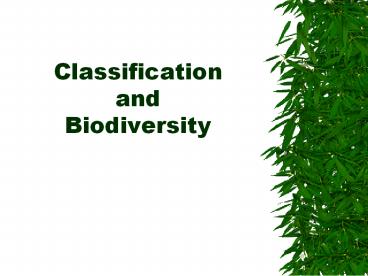Classification and Biodiversity - PowerPoint PPT Presentation
1 / 37
Title:
Classification and Biodiversity
Description:
Classification and Biodiversity Fungi Plants Bryophyta: mosses Tracheophyta: plants with vessels About _1.5 million___ kinds of living organisms are known today and ... – PowerPoint PPT presentation
Number of Views:501
Avg rating:3.0/5.0
Title: Classification and Biodiversity
1
Classification and Biodiversity
2
- About _1.5 million___ kinds of living organisms
are known today and each year thousands more are
identified. - Some experts believe there are as many ___10
million_ different kinds of organisms.
3
Taxonomy
- Classification and naming of living things.
4
Classification Systems
- How is a grocery store classified/ organized?
5
Early classification
- Aristotle
- Classified organisms by how they moved.
- Fly
- Walk
- Swim
- Problems?
6
- John Ray
- First to use the term Species.
- Classified based on structural similarities
7
- Carolus Linnaeus
- Father of modern taxonomy.
- Developed naming system of binomial nomenclature
8
Classification Categories
- Kingdom Animalia
- Phylum Chordata
- Class Mammalia
- Order Primates
- Family Hominidae
- Genus Homo
- Species Sapiens
9
(No Transcript)
10
(No Transcript)
11
Naming organisms
- Nomenclature naming organisms
12
- Common name vs. scientific name
- There may be many common names for one organism.
- Puma, cougar, mountain lion
- Only one scientific name.
- Felis concolor
13
(No Transcript)
14
Binomial Nomenclature
- Hedera helix or Hedera helix
- Italicize or underline scientific name
- Hedera genus
- helix species
15
(No Transcript)
16
Characteristics of the 6 kingdoms
- Monera bacteria
- Cell type prokaryotic
- Body form mostly unicellular
17
- How they get energy
- Photosynthesis
- Absorption
- Chemosynthesis
- No nervous system
- Locomotion some have flagella
18
Protista
- Cell Type Eukaryotic
- Body Form Mostly unicellular
- Energy Some photosynthesis, some
respiration/absorption - No nervous system
- Locomotion
- Flagella whip like tail
- Cilia tiny hairs
- Pseudopods fake feet/ oozing cytoplasm
19
Fungi
- Cell type Eukaryotic
- Body form mostly multi-cellular
- Energy from decomposition/absorption
- No nervous system
- No locomotion
20
Plantae
- Cell type eukaryotic
- Body form multi-cellular
- Energy photosynthesis
- No nervous system
- Little locomotion
21
Animalia
- Cell type eukaryotic
- Body form multi-cellular
- Energy cell respiration/ingestion
- Yes, have nervous system
- Yes, locomotion walk, swim, fly
22
Monera
- Bacteria is the common name for members of this
kingdom. - Where can bacteria be found? Everywhere!
23
Bacteria shapes
- 1. Round (cocci)
- 2. Rod-shaped (bacillus)
- 3. Sprial
24
Two groups of bacteria
- 1. Archaebacteria ancient bacteria
- Adapted to unusual and/or extreme conditions,
such as very hot, very salty, or no-oxygen
environments. Have several different cellular
chemistries from Monera - 2. Eubacteria (monera) true bacteria most
bacteria are this type
25
Examples of bacteria and good things bacteria do
- Watch movie
26
(No Transcript)
27
(No Transcript)
28
Animal like Protists
- Stentor
- Vorticella
- Paramecium
- Amoeba
29
Plant like protists
- Algae green, red, brown
- Spirogyra
- Volvox
- Diatoms
- Euglena
30
Fungus-like protists
- Slime-molds
31
Watch movie
- Feeding styles of protists
32
(No Transcript)
33
Next video
- Sound is only good for 5 min. Stop after that.
34
(No Transcript)
35
Fungi
36
(No Transcript)
37
Plants
- Bryophyta mosses
- Tracheophyta plants with vessels































